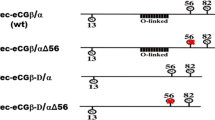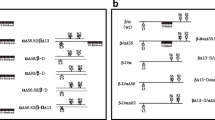Abstract
Equine chorionic gonadotropin (eCG) is a glycoprotein hormone widely used in timed artificial ovulation (TAI) and superovulation protocols to improve the reproductive performance in livestock. Until recently, the only eCG products available in the market for veterinary use consisted in partially purified preparations of pregnant mare serum gonadotropin (PMSG). Here, a bioactive recombinant eCG (reCG) produced in suspension CHO-K1 cells was purified employing different chromatographic methods (hydrophobic interaction chromatography and reverse-phase (RP)-HPLC) and compared with a RP-HPLC-purified PMSG. To gain insight into the structural and functional characteristics of reCG, a bioinformatics analysis was performed. An exhaustive characterization comprising the determination of the purity degree, aggregates and nicked forms through SDS-PAGE, RP-HPLC and SEC-HPLC was performed. Higher order structures were studied by fluorescence spectroscopy and SEC-HPLC. Isoforms profile were analyzed by isoelectric focusing. Glycosylation analysis was performed through pulsed amperometric detection and PNGase F treatment following SDS-PAGE and weak anion exchange-HPLC. Slight differences between the purified recombinant hormones were found. However, recombinant molecules and PMSG exhibited variations in the glycosylation pattern. In fact, differences in sialic acid content between two commercial preparations of PMSG were also obtained, which could lead to differences in their biological potency. These results show the importance of having a standardized production process, as occurs in a recombinant protein bioprocess. Besides, our results reflect the importance of the glycan moieties on eCG conformation and hence in its biological activity, preventing denaturing processes such as aggregation.




Similar content being viewed by others
Data Availability
The data supporting the findings of this study are available within the article.
References
Volkin DB, Sanyal G, Burke CJ, Middaugh CR (2002) Preformulation studies as an essential guide to formulation development and manufacture of protein pharmaceuticals. Pharm Biotechnol 14:1–46
Deechongkit S, Aoki K, Park S, Kerwin B (2006) Biophysical comparability of the same protein from different manufacturers: a Case Study using Epoetin Alfa from Epogen1 and Eprex1. Int J Drug Dev Res 95:1931–1943. https://doi.org/10.1002/jps
Murphy BD (2012) Equine chorionic gonadotrophin: an enigmatic but essential tool. Anim Reprod 9:223–230
Legardinier S, Cahoreau C, Klett D, Combarnous Y (2005) Involvement of equine chorionic gonadotropin (eCG) carbohydrate side chains in its bioactivity; lessons from recombinant hormone expressed in insect cells. Reprod Nutr Dev 45:255–259. https://doi.org/10.1051/rnd:2005018
Legardinier S, Duonor-Cérutti M, Devauchelle G et al (2005) Biological activities of recombinant equine luteinizing hormone/chorionic gonadotropin (eLH/CG) expressed in Sf9 and mimic insect cell lines. J Mol Endocrinol 34:47–60. https://doi.org/10.1677/jme.1.01624
Mastrangeli R, Satwekar A, Cutillo F et al (2017) In-vivo biological activity and glycosylation analysis of a biosimilar recombinant human follicle-stimulating hormone product (Bemfola) compared with its reference medicinal product (GONAL-f). PLoS ONE 12:1–15. https://doi.org/10.1371/journal.pone.0184139
Casarini L, Santi D, Brigante G, Simoni M (2018) Two hormones for one receptor: evolution, biochemistry, actions, and pathophysiology of LH and hCG. Endocr Rev 39:549–592
Gifre L, Arís A, Bach À, Garcia-Fruitós E (2017) Trends in recombinant protein use in animal production. Microb Cell Fact 16:40. https://doi.org/10.1186/s12934-017-0654-4
Alvarez RH, Natal F, Almeida B et al (2017) Biological Activity of different batches of equine Chorionic Gonadotropin as determined by reversed-phase high-performance Liquid Chromatography and in vivo assay. J Adv Med Pharm Sci 12:1–9. https://doi.org/10.9734/JAMPS/2017/31956
Villarraza CJ, Antuña S, Tardivo MB et al (2021) Development of a suitable manufacturing process for production of a bioactive recombinant equine chorionic gonadotropin (reCG) in CHO-K1 cells. Theriogenology 172:8–19. https://doi.org/10.1016/j.theriogenology.2021.05.013
Harlow E, Lane D (1988) Antibodies a LABORATORY MANUAL. Cold Spring Harbor Laboratory Press, New York, USA, pp 53–137
Sievers F, Higgins DG (2018) Clustal Omega for making accurate alignments of many protein sequences. Protein Sci 27:135–145. https://doi.org/10.1002/pro.3290
Ikai A (1980) Thermostability and aliphatic index of globular proteins. J Biochem 88:1895–1898. https://doi.org/10.1093/oxfordjournals.jbchem.a133168
Kyte J, Doolittle RF (1982) A simple method for displaying the hydropathic character of a protein. J Mol Biol 157:105–132. https://doi.org/10.1016/0022-2836(82)90515-0
Alvarez RH, Natal FL, Nogueira C, Pinto Ribela MT, de Almeida BE, de Oliveira J, Ezequiel, Bartolini P (2016) Physical-chemical and biological characterization of different preparations of equine chorionic gonadotropin. 17:459–465. https://doi.org/10.4314/ajcem.v12i3
Hermentin P, Witzel R, Kanzy EJ et al (1996) The hypothetical N-glycan charge: a number that characterizes protein glycosylation. Glycobiology 6:217–230. https://doi.org/10.1093/glycob/6.2.217
Ribela M, Gout P, de Oliveira J, Bartolini P (2006) HPLC Analysis of Human Pituitary Hormones for Pharmaceutical Applications. Curr Pharm Anal 2:103–126. https://doi.org/10.2174/157341206776819300
Murphy BD, Martinuk SD (1991) Equine chorionic gonadotropin. Endocr Rev 12:27–44. https://doi.org/10.1210/edrv-12-1-27
Almeida BE, Oliveira JE, Damiani R et al (2011) A pilot study on potency determination of human follicle-stimulating hormone: a comparison between reversed-phase high-performance liquid chromatography method and the in vivo bioassay. J Pharm Biomed Anal 54:681–686. https://doi.org/10.1016/j.jpba.2010.10.018
Alvarez RH, Natal FLN, Almeida BE et al (2016) Effect of cold stress on physicochemical characteristics and biological activity of equine chorionic gonadotropin. Anim Reprod 13:750–755. https://doi.org/10.21451/1984-3143-AR781
Callis PR (2014) Binding phenomena and fluorescence quenching. II: photophysics of aromatic residues and dependence of fluorescence spectra on protein conformation. J Mol Struct 1077:22–29. https://doi.org/10.1016/j.molstruc.2014.04.051
Garidel P, Hegyi M, Bassarab S, Weichel M (2008) A rapid, sensitive and economical assessment of monoclonal antibody conformational stability by intrinsic tryptophan fluorescence spectroscopy.1201–1211. https://doi.org/10.1002/biot.200800091
Albrecht CJ, Lakowicz JR (2008) Principles of Fluorescence Spectroscopy Principles of Fluorescence Spectroscopy. 3rd edition. Anal Bioanal Chem 390 https://doi.org/10.1007/s00216-007-1822-x
Gifre L, Arís A, Bach À, Garcia-Fruitós E (2017) Trends in recombinant protein use in animal production. Microb Cell Fact 16:1–17. https://doi.org/10.1186/s12934-017-0654-4
Akash MSH, Rehman K, Tariq M, Chen S (2015) Development of therapeutic proteins: advances and challenges. Turkish J Biology 39:343–358. https://doi.org/10.3906/biy-1411-8
Bousfield GR, Liu W, Ward N (1987) Structural studies on equine glycoprotein hormones. J Biol 262:8610–8620
Hokke CH, Roosenboom MJH, Thomas-Oates JE et al (1994) Structure determination of the disialylated poly-(N-acetyllactosamine)-containing O-linked carbohydrate chains of equine chorionic gonadotropin. Glycoconj J 11:35–41. https://doi.org/10.1007/BF00732430
DAMM JBL, HÅRD K, KAMERLING JP et al (1990) Structure determination of the major N- and O‐linked carbohydrate chains of the β subunit from equine chorionic gondotropin. Eur J Biochem 189:175–183. https://doi.org/10.1111/j.1432-1033.1990.tb15474.x
Min KS, Park JJ, Byambaragchaa M, Kang MH (2019) Characterization of tethered equine chorionic gonadotropin and its deglycosylated mutants by ovulation stimulation in mice. BMC Biotechnol 19:1–9. https://doi.org/10.1186/s12896-019-0550-6
Legardinier S, Klett D, Poirier JC et al (2005) Mammalian-like nonsialyl complex-type N-glycosylation of equine gonadotropins in Mimic™ insect cells. Glycobiology 15:776–790. https://doi.org/10.1093/glycob/cwi060
Lee S, Byambaragchaa M, Kim J et al (2017) Biochemical Characterization of Recombinant Equine Chorionic Gonadotropin (rec-eCG), Using CHO Cells and PathHunter Parental Cells Expressing Equine Luteinizing Hormone /Chorionic Gonadotropin Receptors (eLH/CGR). 27:864–872
Byambaragchaa M, Choi S-H, Joo H-E et al (2021) Specific Biological activity of equine Chorionic Gonadotropin (eCG) glycosylation Sites in cells expressing equine luteinizing Hormone/CG (eLH/CG) receptor. Dev Reprod 25:199–211. https://doi.org/10.12717/dr.2021.25.4.199
Zhang L, Luo S, Zhang B (2016) Glycan analysis of therapeutic glycoproteins. MAbs 8:205–215. https://doi.org/10.1080/19420862.2015.1117719
Planinc A, Bones J, Dejaegher B et al (2016) Glycan characterization of biopharmaceuticals: updates and perspectives. Anal Chim Acta 921:13–27
Fares F, Azzam N (2019) Development of long-acting recombinant glycoprotein hormones by increasing the carbohydrate content. Drug Discov Today 24:1017–1022. https://doi.org/10.1016/j.drudis.2019.01.017
Ceaglio N, Gugliotta A, Tardivo MB et al (2016) Improvement of in vitro stability and pharmacokinetics of hIFN-α by fusing the carboxyl-terminal peptide of hCG β-subunit. J Biotechnol 221:13–24. https://doi.org/10.1016/j.jbiotec.2016.01.018
Flintegaard T, Thygesen P, Rahbek-Nielsen H et al (2010) N-glycosylation increases the circulatory half-life of human growth hormone. Endocrinology 151:5326–5336. https://doi.org/10.1210/en.2010-0574
van Zuylen CWEM, de Beer T, Rademaker GJ et al (1995) Site-specific and complete enzymic deglycosylation of the native human chorionic gonadotropin α‐Subunit. Eur J Biochem 231:754–760. https://doi.org/10.1111/j.1432-1033.1995.0754d.x
Lapthorn AJ, Harris DC, Littlejohn A et al (1994) Crystal structure of human chorionic gonadotropin. Nature 369:455–461. https://doi.org/10.1038/369455a0
Crispo M, Meikle MN, Schlapp G, Menchaca A (2021) Ovarian superstimulatory response and embryo development using a new recombinant glycoprotein with eCG-like activity in mice. Theriogenology 164:31–35. https://doi.org/10.1016/j.theriogenology.2021.01.012
Thennati R, Singh SK, Nage N et al (2018) Analytical characterization of recombinant hCG and comparative studies with reference product. Biologics 12:23–35. https://doi.org/10.2147/BTT.S141203
Author information
Authors and Affiliations
Contributions
JV, DF and SA carried out the production of reCG in prefusion bioreactor; MBT carried out the first purification stage (the started material); JV performed the bioinformatic analysis; MCR and PEM designed and performed the experiments; MCR and NC wrote the manuscript. CP revised the manuscript. All the authors approved the manuscript.
Corresponding author
Ethics declarations
Conflict of Interest
The authors declare that they have no conflict of interest.
Additional information
Publisher’s Note
Springer Nature remains neutral with regard to jurisdictional claims in published maps and institutional affiliations.
Electronic Supplementary Material
Below is the link to the electronic supplementary material.
Rights and permissions
Springer Nature or its licensor (e.g. a society or other partner) holds exclusive rights to this article under a publishing agreement with the author(s) or other rightsholder(s); author self-archiving of the accepted manuscript version of this article is solely governed by the terms of such publishing agreement and applicable law.
About this article
Cite this article
Rodríguez, M.C., Mussio, P.E., Villarraza, J. et al. Physicochemical Characterization of a Recombinant eCG and Comparative Studies with PMSG Commercial Preparations. Protein J 42, 24–36 (2023). https://doi.org/10.1007/s10930-023-10092-x
Accepted:
Published:
Issue Date:
DOI: https://doi.org/10.1007/s10930-023-10092-x




